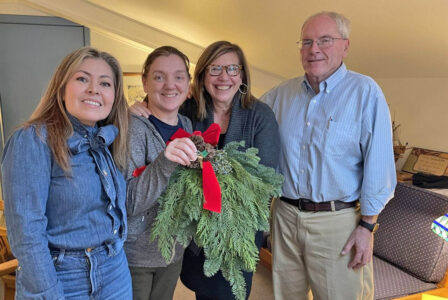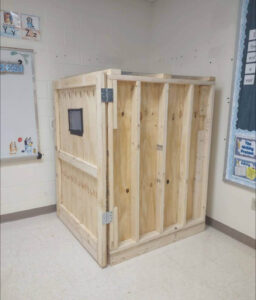A neighborhood 150 years in the making
- The developers of the Trudeau Village stand in front of one of the buildings where apartments and business space are being built in the former buildings of the Trudeau Sanatorium. (Enterprise photo — Aaron Marbone)
- The developers of the Trudeau Village stand in front of one of the buildings where apartments and business space are being built in the former buildings of the Trudeau Sanatorium. (Enterprise photo — Aaron Marbone)

The developers of the Trudeau Village stand in front of one of the buildings where apartments and business space are being built in the former buildings of the Trudeau Sanatorium. (Enterprise photo — Aaron Marbone)
SARANAC LAKE — A century-and-a-half ago, Edward Livingston Trudeau was drumming up support to build the Adirondack Cottage Sanitarium, an experimental community to treat tuberculosis. It was an odd idea, and took initial investors some time to get on board, but Trudeau believed strongly that it would be successful.
One hundred and fifty years later, developers Wayne Zukin, Scott Zukin, Sue Smith-Zukin and Brian Draper have a vision of turning the sanatorium buildings, which have been vacant for quite a while now, into a neighborhood. It’s an odd idea, but they’ve gotten people on board.
On Thursday, they held a groundbreaking ceremony for the “Trudeau Village” — an extensive project to turn the former health community of cure cottages and research buildings into 89 apartments with business space.
“We’re trying to create a little village within a village,” Wayne said.
As they unveiled new signs for the ends of the property in front of the massive 129-year-old administration building, the sound of asbestos abatement reverberated from inside.

The developers of the Trudeau Village stand in front of one of the buildings where apartments and business space are being built in the former buildings of the Trudeau Sanatorium. (Enterprise photo — Aaron Marbone)
Wayne said this wasn’t really a “groundbreaking” ceremony. They’ve already got the buildings. The goal with their company, Cure Cottage Development, is to restore the buildings.
“The best way to preserve a historic building is to use it,” Wayne said.
Vision
In Trudeau’s autobiography, he speaks about the money, effort and anxiety that went into building the sanatorium. It was a large, off-beat project with unclear results. It took a lot of convincing to get people on board with funding and supporting it. But Trudeau’s vision for the tuberculosis treatment center was as infectious as the disease it sought to treat. The “San” ended up contributing to the growth of Saranac Lake, bringing industry, attention and thousands of people to the small town.
Draper and the Zukins are hoping for a similar success with their project. Historic Saranac Lake Executive Director Amy Catania sees a similar spirit of optimism and drive in the Cure Cottage Development leaders as Trudeau had.
“I’m not a quitter,” Draper said. “And I’ve always seen the end goal. I see the project finished.”
He said this while walking on rough unfinished floors, through hallways with peeling paint and around heaps of work tools. This is the exciting part of the project, he said — when things actually start happening.
The Zukins are no strangers to historic restoration work.
“We were raised in a Victorian house, so that was always under renovation,” Scott said.
They cut their teeth renovating smaller old buildings with their father.
“You always have to be prepared for the unknown,” Scott said.
Draper said they have invested a “tremendous amount” of their own money.
Saranac Lake Mayor Jimmy Williams called the Trudeau Village “the project of a lifetime.” He’s excited about the housing opportunity it poses, and praised the developers for tackling the “monumental” task of restoring the historic buildings. When he got a tour three years ago, he said he left anxious seeing the work ahead of them.
“There is a lifetime of work here,” Williams said.
But he added that the hard part — the planning and funding — was behind them.
Draper said it took the bank some convincing to sign on to the project. NBT Bank Senior Vice President Craig Seybolt said they understand the housing need the project addresses.
These will be market rate apartments. Due to the high cost of construction for historic renovation, Draper said they couldn’t do low-income, affordable housing.
The project was awarded a $1.3 million Restore New York grant in 2022. Draper said they weren’t able to get more grants, and it seems unlikely that there will be many more available in the near future.
Draper said the first project phase is at an estimated $6.5 million. The total 29-building project is estimated to cost $15 million. Building costs are going up as the U.S.’s tariff war with the world makes material more expensive, but Draper said they should be able to weather them for now.
Scott said people might be able to start moving in as soon as next spring. With historic construction, though, it’s hard to tell. Around 35 people are already living in the homes of former doctors on the property. These buildings were already furnished with all the amenities needed for apartments.
–
History of the property
–
Wayne held a paper of notes, but didn’t need to consult them when he gave a short history lesson on Trudeau. He knew the story well.
Trudeau, a doctor who was suffering from tuberculosis himself, came up here to die. An avid fisherman and hunter, he wanted to spend time in nature before his death.
But his health was restored. Trudeau attributed this to the fresh air, rest and clean living he got here.
Trudeau gave up his favorite fox run to build an experimental sanatorium on the side of Mount Pisgah, where patients sat outside on porches year-round, breathing the fresh air, resting and getting moderate exercise. This method of treating tuberculosis became known colloquially as “the cure,” though it wasn’t really a cure — more of a way of encouraging stronger immune systems. But in a time when tuberculosis killed one-in-seven people, it was hope.
Wayne noted that the names on several of the buildings are of people who got better at the sanatorium and donated to it to show their gratitude. Trudeau kept researching for a true cure until his death in 1915.
When a true cure for tuberculosis came in the 1940s and 50s through developments in antibiotics, Trudeau’s family sold the property to American Management Association and used the funds from the sale to found the Trudeau Institute, which still researches infectious diseases, including tuberculosis, in Saranac Lake today. Tuberculosis still kills more than 1 million people worldwide every year.
The AMA filled the property with 400 employees and kept the place maintained for years. Scott said the buildings need work to be livable spaces, but they’re not in bad shape for their age. AMA took care of the roofs, which he said was crucial, and kept them heated through the winters.
“This building’s built like a bomb shelter,” Continuum Renewables Owner Joe Adeigbo said of the administration building, adding that it’s got three times the floor load capacity of a typical house.
Eventually, with the advent of the internet, AMA shrunk and the buildings started to deteriorate as they weren’t being used. The property sold in 2019 and AMA still rents a building from the developers.
The coronavirus pandemic hit three months after the developers bought the property. This slowed their plans down, but also gave them time to talk with the community. They opened the road to the public for people to walk and drive through to enjoy the buildings and landscape.
These discussions also changed their plans. Initially, they were thinking of turning the buildings into a resort of some sort. But they saw the desperate need for housing in the village and decided to focus on meeting that need.
Phase one involves putting 27 apartments in the 21,706-square-foot administration building and 10,240-square-foot cold storage building.
Adeigbo said the state Historic Preservation Office came in and identified historic items from the time period — trim, doors, accents — to restore or recreate.
As someone who has done a lot of work with historic buildings, Adeigbo said the administration building is one of the odder ones he’s seen. It has a Dutch, lodge-type feeling he hasn’t seen before.
The apartments will be created by removing walls between the small hospital-style rooms to create larger living spaces, with plumbing and electrical utilities being added in the near future. Because patients all ate at the communal cafeteria in the administration building, none of the rooms they’re turning into apartments have kitchens. They’re planning where to install these in each unit now.
Bloomingdale-based Hex and Hop Brewing has a brewing location at the sanatorium stables. Wayne said they’re planning for a “maker space” there with art studios and galleries.
On the first floor of the administration building, also called the Dodd building, Wayne said they hope to land a coffee or sandwich shop.
Wanye said the road which is currently called AMA Way will become an extension of Park Avenue.
There’s 25 acres of land behind the building complex, going up Mount Pisgah, which could be developed in the future. Wanye also said they’re working with the Barkeater Trails Alliance to build connector trails to Mount Pisgah.
After unveiling the signs on Thursday, Wayne told the assembled crowd to turn around to see the clouds on McKenzie Mountain across the Saranac River. This was the view that convinced Trudeau to establish his sanatorium where the buildings are today.








